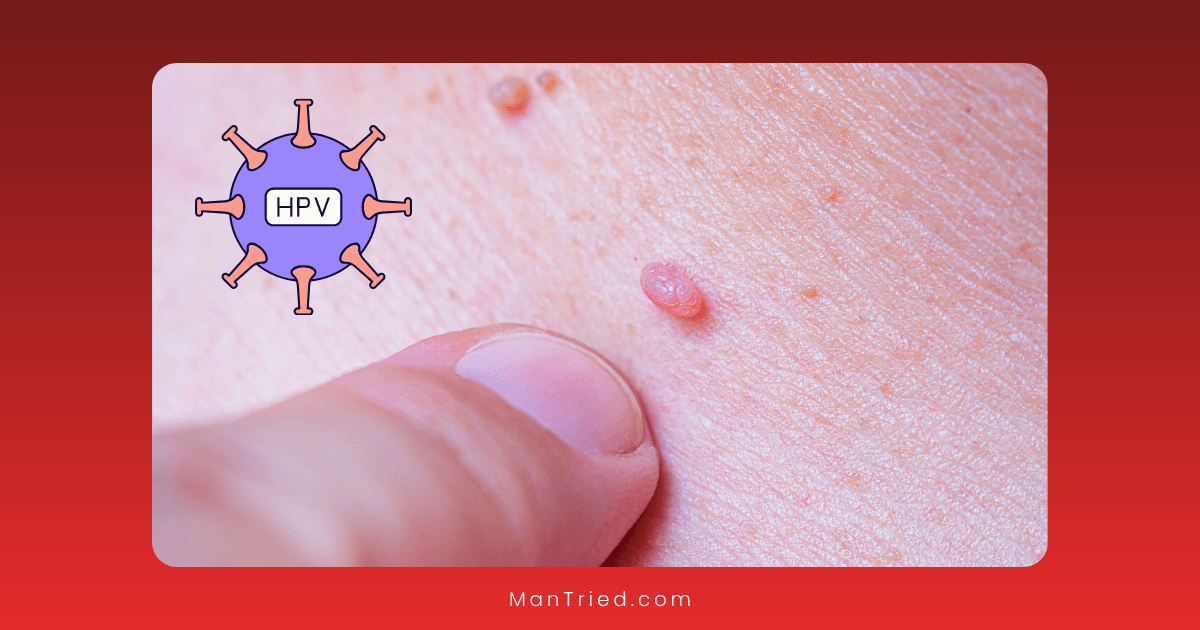HPV in Men: The Silent STI and Its Consequences

Human Papillomavirus (HPV) is often described as a women’s health issue, primarily due to its well-known connection to cervical cancer. However, this common sexually transmitted infection affects men just as frequently—and often more silently. With limited testing options and typically no symptoms, HPV can fly under the radar in men while potentially causing serious health consequences.
This comprehensive guide explores what men need to know about HPV: how it affects male health, its cancer risks, testing limitations, prevention strategies, and what to do if you’ve been diagnosed.
Understanding HPV: The Basics
Human Papillomavirus isn’t a single virus but a group of more than 200 related viruses, about 40 of which can be sexually transmitted. According to the Centers for Disease Control and Prevention (CDC), HPV is the most common sexually transmitted infection in the United States.
Prevalence in Men
The statistics are striking:
- Approximately 1 in 3 men worldwide has an active HPV infection
- Nearly half of asymptomatic men (45.2%) carry genital HPV infections
- About 20-30% of men carry high-risk oncogenic (cancer-causing) HPV types
- An estimated 80% of sexually active Americans will contract HPV at some point
Dr. Anna Giuliano, a leading HPV researcher at Moffitt Cancer Center, notes: “HPV is so common that nearly all sexually active people will get it at some point in their lives, even if they have only one sexual partner.”
Transmission
HPV spreads primarily through:
- Vaginal, anal, or oral sex
- Skin-to-skin genital contact (even without penetration)
- Rarely, from mother to child during birth
Unlike some STIs, condoms provide only partial protection against HPV because the virus can infect areas not covered by condoms.
Why HPV is “Silent” in Men
One of the most challenging aspects of HPV in men is its typically asymptomatic nature:
- No Symptoms: Most men with HPV never develop any visible signs of infection
- No Routine Testing: Unlike women, who can be tested for HPV during cervical screening, there is no FDA-approved HPV test for men
- Natural Clearance: In about 90% of cases, the immune system clears the infection within two years without treatment
This “silent” nature creates a perfect storm: men can unknowingly carry and transmit the virus while remaining completely unaware of their infection status.
Visible Symptoms: When HPV Does Show Signs
While most HPV infections in men cause no symptoms, some strains (particularly types 6 and 11) can cause genital warts:
- Small, flesh-colored bumps or groups of bumps in the genital area
- Warts may be flat or raised, small or large
- They can appear on the penis, scrotum, groin, thighs, or around or inside the anus
- Less commonly, warts may appear in the mouth or throat from oral HPV infection
According to the American Sexual Health Association, genital warts, while concerning, are caused by “low-risk” HPV types that rarely lead to cancer.
The Cancer Connection: High-Risk HPV in Men
The more serious concern with HPV in men involves “high-risk” types (particularly HPV 16 and 18) that can lead to cancer. According to the CDC, approximately 47,984 new cases of HPV-associated cancers are diagnosed each year in the United States, with 21,704 of these occurring in men.
Types of HPV-Related Cancers in Men
Oropharyngeal (Throat) Cancer
- Incidence: Approximately 21,474 cases annually in the U.S., with about 70% (15,200) attributed to HPV
- Demographics: Four times more common in men than women
- Trend: Has surpassed cervical cancer as the most common HPV-related cancer
- Symptoms: Persistent sore throat, earaches, hoarseness, swollen lymph nodes, pain when swallowing, unexplained weight loss
Dr. Erich Sturgis, professor of head and neck surgery at MD Anderson Cancer Center, explains: “We’re seeing an epidemic of HPV-related oropharyngeal cancers, particularly in younger men without traditional risk factors like smoking and heavy alcohol use.”
Penile Cancer
- Incidence: Approximately 1,381 cases annually in the U.S., with about 63% (900) linked to HPV
- Risk factors: Uncircumcised men have a higher risk, as do smokers and those with compromised immune systems
- Symptoms: Changes in skin color, thickening of the skin, tissue buildup, sores or ulcers that don’t heal, bleeding, unusual discharge, swelling
While relatively rare in the United States, penile cancer rates are significantly higher in parts of South America, Africa, and Southeast Asia.
Anal Cancer
- Incidence: About 7,854 cases annually in the U.S., with approximately 91% (7,200) caused by HPV
- Risk groups: Higher rates among men who have sex with men and immunocompromised individuals
- Symptoms: Anal bleeding, pain, pressure, itching, discharge, or changes in bowel habits
Research published in the Journal of the National Cancer Institute shows that the incidence of anal cancer has been increasing by about 2.2% annually over the past decade.
The Delayed Timeline
A critical aspect of HPV-related cancers is their delayed development:
- Initial HPV infection typically occurs in teens or early adulthood
- Cancer development can take 20-30 years after initial infection
- This explains why HPV-related cancers often appear in men in their 40s, 50s, or 60s
Testing Limitations: Why Men Can’t Simply “Get Checked”
One of the most frustrating aspects of HPV in men is the limited testing options:
Current Testing Situation
- No FDA-approved general HPV test for men: Unlike women, who can receive HPV testing during cervical screening
- No blood test: HPV testing requires direct sampling from potentially infected sites
- Research-only anal Pap tests: While similar to cervical Pap tests for women, these are not standardized for clinical use
Limited Screening Options
For most men, HPV screening is limited to:
- Visual inspection: Healthcare providers can examine the genital area for visible warts
- Specialized testing in research settings: Not widely available in standard clinical practice
- Anal Pap tests for high-risk groups: Sometimes recommended for men who have receptive anal sex or are immunocompromised, though not universally available
Dr. Joel Palefsky, a leading HPV researcher at the University of California, San Francisco, notes: “The lack of standardized HPV testing for men represents a significant gap in our approach to preventing HPV-related diseases.”
Prevention Strategies: Protecting Yourself and Partners
Despite the challenges in detection, several effective prevention strategies exist:
HPV Vaccination
The HPV vaccine represents the most effective prevention method:
- Recommendation: The CDC recommends vaccination for all boys and girls at age 11-12
- Catch-up vaccination: Available through age 26 for those not vaccinated earlier
- Adult vaccination: Some adults ages 27-45 may benefit from vaccination after discussing risks with their healthcare provider
- Effectiveness: Prevents over 90% of cancers caused by HPV types covered by the vaccine
- Coverage: Current vaccines protect against HPV types that cause most HPV-related cancers
According to the American Cancer Society, widespread HPV vaccination could prevent tens of thousands of cancer cases each year.
Safer Sex Practices
While not 100% effective against HPV, safer sex practices reduce risk:
- Condom use: Provides partial protection by covering some potentially infected areas
- Limiting partners: Fewer sexual partners generally means lower exposure risk
- Communication: Discussing sexual health history with partners
Regular Health Check-ups
While specific HPV testing may be limited, regular health examinations can help:
- Dental check-ups: Dentists and dental hygienists may spot oral HPV lesions
- Routine physicals: Allow healthcare providers to examine for visible genital warts
- Reporting changes: Promptly discussing any unusual symptoms with healthcare providers
If You’re Diagnosed: Management and Next Steps
If you do discover you have HPV—either through visible warts or a partner’s diagnosis—here’s what to know:
Treatment for Genital Warts
Several treatment options exist for visible genital warts:
- Provider-applied treatments: Cryotherapy (freezing), surgical removal, or chemical treatments
- Prescription medications: Creams or solutions that can be applied at home
- Immune response modifiers: Medications that help your immune system fight the virus
It’s important to note that while these treatments remove warts, they don’t cure the underlying HPV infection.
Monitoring for Cancer Risk
If you’ve had high-risk HPV types or are in high-risk groups:
- Regular oral examinations: For those with oral HPV
- Anal cancer screening: For men who have sex with men or are immunocompromised
- Prompt attention to symptoms: Investigating any unusual changes in the genital, anal, or oral regions
Partner Considerations
If you’ve been diagnosed with HPV:
- Partner notification: While difficult, informing sexual partners allows them to make informed health decisions
- Understanding transmission timing: HPV can remain dormant for years, so a current diagnosis doesn’t necessarily indicate recent infection
- Reducing transmission risk: Using barriers and considering vaccination if partners are eligible
The Psychological Impact: Dealing with an HPV Diagnosis
The psychological aspects of an HPV diagnosis can be challenging:
Common Reactions
- Confusion: Many men have limited knowledge about HPV before diagnosis
- Stigma: Despite its commonness, HPV still carries social stigma as an STI
- Relationship concerns: Worries about transmission to partners or implications for current relationships
- Cancer anxiety: Concerns about future cancer risk
Coping Strategies
- Education: Learning accurate information about HPV helps combat misconceptions
- Support resources: Organizations like the American Sexual Health Association offer resources specifically for those with HPV
- Healthcare provider discussions: Open conversations with healthcare providers can address specific concerns
- Perspective: Remembering that HPV is extremely common and most infections clear naturally
The Future of HPV Management in Men
Research continues to advance our understanding and management of HPV in men:
Emerging Research
- Improved testing methods: Researchers are developing more accessible testing options for men
- Enhanced vaccines: Next-generation vaccines may cover more HPV types
- Treatment advances: New approaches to treating persistent HPV infections are under investigation
Changing Guidelines
Medical guidelines continue to evolve:
- Expanded vaccination recommendations: More emphasis on vaccinating boys and men
- Screening protocols: Developing standardized screening for high-risk groups
- Public health approaches: Increased education and awareness campaigns
Conclusion: Taking Control of HPV Health
Despite being “silent,” HPV doesn’t have to be a source of undue anxiety. By understanding the virus, taking preventive measures, and knowing when to seek medical attention, men can effectively manage their HPV-related health risks.
The most important takeaways:
- Get vaccinated if eligible: The HPV vaccine is safe, effective, and the best protection against HPV-related cancers
- Practice safer sex: While not perfect protection, condoms and communication reduce risk
- Know the symptoms: Familiarize yourself with potential signs of HPV-related problems
- Regular check-ups: Maintain routine healthcare visits where providers can identify potential issues
- Stay informed: As research advances, new prevention and management strategies will emerge
By addressing HPV proactively, we can reduce its impact on men’s health and work toward eventually eliminating HPV-related cancers altogether.






